- You are here:
- Home »
- Blog »
- Sell Products
Category Archives for Sell Products

The One Funnel Away Challenge Review
Have you heard of the One Funnel Away Challenge of Russell Brunson and ClickFunnels? But what exactly is the One Funnel Away Challenge and for whom is it for?
Learn more about it in this article!
What is the One Funnel Away Challenge
The One Funnel Away Challenge is a four weeks training program by the founder of ClickFunnels Russell Brunson. Each day you’ll get training videos and todo tasks you’ll need to work on. In addition, you’ll get a physical workbook and some other cool stuff I’ll explain more in detail below!
The goal of the training program is to help you launching a high converting funnel for your product or service.
How is the One Funnel Away Structured?
Each week of the training program is designed to work on one important part of your funnel. Let’s dive into the different weeks and what you’ll learn in each week.
Pre-training, Belief
The first week is all about your mindset. In this pre-training
Week #1: Hook, Story, Offer
After the pre-training the real first week of your training starts. In this week you’ll learn everything about creating and structuring your offer. Each part of a successful funnel can be structured into hook, story, and offer. In the One Funnel Away
Week #2: Your Hooks and Stories
In the second week of the training, you’ll learn everything about hooks and stories. You’ll learn how to create an epiphany bridge (Hint: If you have never heard of the epiphany bridge, check out DotComSecrets) and how to create and test your hooks and stories.
Week #3: The Funnel
In the third week of the training, you’ll finally create your first funnel. You’ll learn how to create your squeeze page, your sales page and all the parts you need for your funnel. (Hint: All the videos are created for ClickFunnels – Check out here my review)
Week #4: Make It Rain
After creating your first funnel in week 3 you’ll now learn how to fill your funnel with traffic. You’ll learn more about the three types of traffic and the concept of the dream 100 (hint: check out Expert Secrets). You’ll also learn what to do if your funnel flops.
Week #5: Post Training
After the four weeks training you should now have a working funnel. But what should you do now? In the post training week you’ll learn what to do the next 30, 60 and 90 days so you can keep up the momentum and scale your funnel.
What does it cost?
The One Funnel Away Challenge costs $100. This includes the four weeks training plus some bonuses. One of these bonuses is the 30 Days book. In this book, Russell Brunson asked 30 two-comma club winner (people who have made over 1 million in sales with ClickFunnels) what they would do if they had to start from scratch with no money, no following, no email list, etc.
What this book includes is 30 different plans how successful online entrepreneurs would create their first funnel/online business if
What does it include?
The One Funnel Away Challenge includes:
- 30 Days of Video Missions from Russell Brunson
- 30 Days of Coaching from Stephen Larson & Julie Stoian
- One Funnel Away Challenge Customized Kit
- Physical Copy of the Challenge Workbook
- MP3 Player
- 30 Days Hardcover Book
- Unlimited Access to 30 days Interviews
- Behind the Scenes-Two Comma Club Interviews
Who is the One Away Challenge for?
I believe that the One Funnel Away challenge is an amazing training program for everyone who wants to successfully build an online business. This training can be great for beginners as well as experienced marketers. I’m already working in the online marketing business for almost 2 years but I have learned many new concepts and insights that are really helpful.
Conclusion
The One Funnel Away challenge is a four weeks training program by Russell Brunson designed to help you building your first profitable funnel whether you’re an experienced marketer or beginner.
They could sell this training easily for several thousand dollars but all you need to pay is $100. I have made the challenge myself and I believe it is one of the best training programs in the online marketing space.
Not only, you’ll get training videos but also assignments that guide you to your first successful funnel. Here you can join the challenge!
Have you already done the One Funnel Away challenge? What do you think about it? Let me know by leaving a comment below!
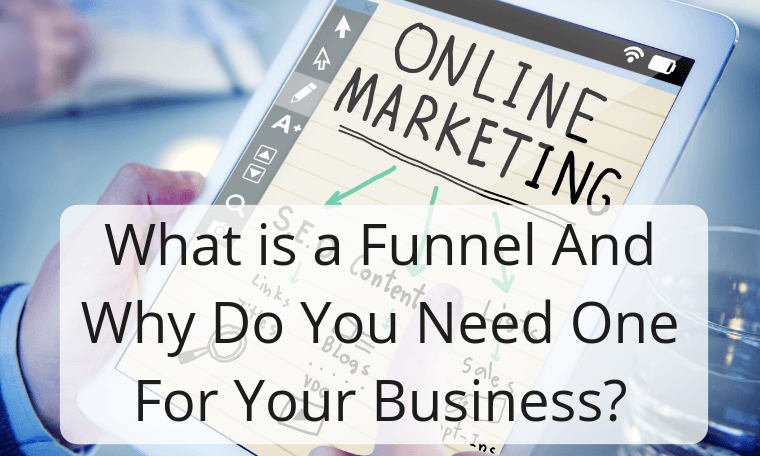
What is a Funnel And Why Do You Need One For Your Business?
While talking to other entrepreneurs what their biggest challenge about digital marketing is I usually get two different answers:
- “I’m asking myself how I can get more customers from the internet. There are so many strategies and I don’t know which is right for me.”
- “How should I have time for Facebook, a blog, …?”
I can understand that.
How about you?
In this article, I want to show you a proven strategy on how you can save a lot of time by automating your processes and how to get more ideal customers for your business.
With a funnel.
Your website is one of your employees and it has to do a certain job to do.
I’m pretty sure that every entrepreneur needs at least one sales funnel.
What is a funnel?
I’m pretty sure you know a funnel you can use in the kitchen.
A funnel has a big entrance and a much smaller exit.
The word funnel can be a little confusing when it’s used in the online marketing space because not everything what is entering our funnel on the top is exiting our funnel on the bottom. You can rather see your funnel as a filter.
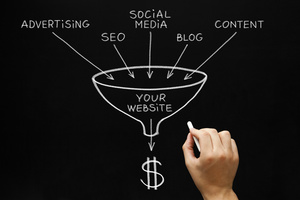
We are using this funnel to get from a huge amount of visitors (huge entrance) to a smaller amount of people who are interested in our product or customers (small exit).
What kind of funnels are there?
If you listen to people talking about funnels they are usually talking about three different categories:
- sales funnel
- marketing funnel
- conversion funnel
However, all these funnels are the same.
Usually, the marketing takes place before a sale so you can split them into two different funnels. But the goal of both funnels is a conversion.
A conversion can be filling out a form or a sale.
Conversion: A conversion is the transformation of a status. For example, a lead converts into a customer.
In this context the conversion rate is important. The conversion rate describes the number of people who took a specific action in percent. When 100 visitors on our website convert into 5 customers we have a conversion rate of 5%.
Example funnel for coaches and consultants
Let’s have a look at a funnel and how it can help us attract new customers. The following drawing is an example funnel for coaches and consultants:

Let’s have a look at the elements
- The funnel starts an ad (AD) that people click on. The ad can be on Facebook or Google for example.
- The person clicking on the ad comes to our landing page (LP) where they can enter their email to get something for free (pdf report, free training, etc.)
- After entering their email address the visitor comes to our thank you page (TP) with contains a video and a button. In the video, you solve a problem of your visitor and they can apply for a free strategy coaching by clicking on the button.
- If they click the button (Yes) they come to a questionnaire (questions) where they have to answer important questions for the strategy call.
- After finishing the questions they come to a calendar (calendar) to choose a date for the call.
- The strategy call (call) takes place and hopefully…
- You get a sale of your coaching/consulting product (sale)
If the visitor visiting the thank you page doesn’t click on the button (No) they get an automated email sequence where you give them valuable content and build up trust.
The goal of the email sequence is to get them answering the questionnaire and get them on the phone with you.
In this example, we have an ad, which points directly to our landing page. Instead of an ad, we can also have other starting points, like:
- an email list
- a blog article
- social media post
- YouTube Video
Why do I need a funnel?
Summarized in two points:
- Processes can be automated. Instead of sending out emails manually you can automate the whole process with only one tool.
- With a funnel, you can build up trust and show people why you are an expert in your field (higher conversions)
Before you build your first funnel, you need to ask yourself some questions:
The 4-questions of a funnel
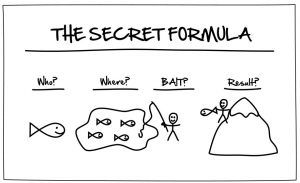
- WHO: Who is your ideal customer?
- WHERE: Where is your ideal customer?
- BAIT: Which bait can attract your customer?
- RESULT: Which solution are you offering him?
Who?
Before you start building a funnel you need to know your ideal customer.
What interests does your ideal customer have? How old are they? What kind of job do they have?
The better you know your ideal customer the better you can speak their language and attract them into your funnel.
Where?
Where does your ideal customer spend their time online? Is it on Facebook? Is it on Instagram? Is it in online forums? What blogs, magazines or newspaper are they reading?
Bait?
What problem can you save with your bait? You bait can be resources, a case study or a checklist.
Result?
How can you solve the problem of your ideal customer?
It’s not about which product you can sell them but rather which result they will get with your product.
If you have a solution to their problem the price is not as important anymore.
Which tools and elements do I need for a funnel?
Depending on your industry and your goal your funnel can look different.
However, these are the elements you (almost) need every time:
- Email-Marketing Software – Your email marketing software should be able to build up automations based on the behavior of your visitor (Did they click on the button or not)
- Landing Page Software – A tool that helps you creating high-converting landing pages.
- Lead Magnet – You need some kind of gift for your visitor so they exchange their email address.
An element which can be also very effective:
- Webinars – Possibility to do webinars (automated or manually)
Which tool should you use?
For each element in your funnel, there are many tools you can use. However, I would recommend using one tool for all elements. I can recommend ClickFunnels which is a sales funnel builder tool. ClickFunnels comes with an easy to use landing page creator, powerful email marketing automation and everything you need for your funnel (webinars, sales pages, affiliate program etc. The greatest thing about ClickFunnels? You can test ClickFunnels for free for 14 days. Click here to start your free trial!
I’m using ClickFunnels for over 3 years now and I never have been more amazed by a single online marketing tool!
Conclusion
As you can see, a funnel is a perfect chance to have a system which brings you new customers, fully automated. Your sales funnel works 24/7 and never needs a pause or vacation.
However, building a converting funnel is a long-term strategy.
You need to test and optimize the different elements of your funnel to get the best results possible.
Maybe you don’t have the perfect lead magnet at the beginning or your follow-up sequence isn’t working as supposed. That’s part of your work.
That’s why you should always have a look at your ideal customer and ask yourself the four questions (Who, Where, Bait, Result).
If you keep improving your funnel step by step you’ll get the results you want to have.
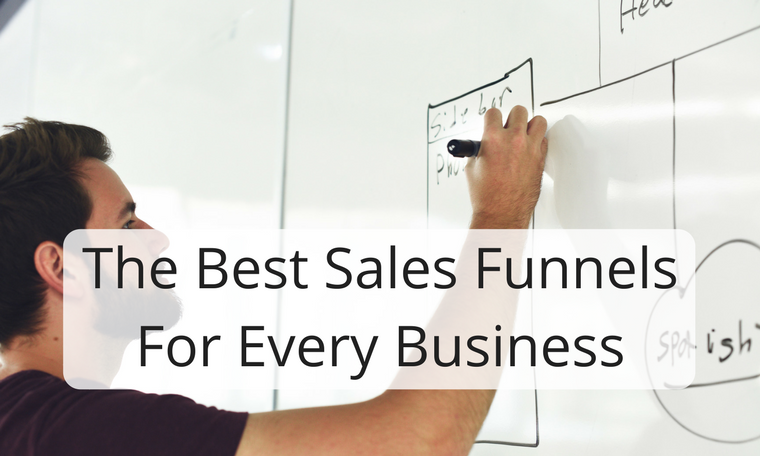
The Best Sales Funnels For Every Business
I believe that if you have a business you need a sales funnel. It doesn’t matter if you have an online business or an offline business, you always need a sales funnel. But what are there for sales funnels and which one should you use for your business?
In this article I will show you the six core funnels and for which type of business this funnel can be used. Thanks to the share funnel feature of ClickFunnels you can easily import the funnel into your account. If you never heard of ClickFunnels before you can check out my review here.
Best Selling Book Funnel
The first funnel we will have a look at is the Best Selling Book Funnel.
Who is this funnel for?
The best selling book funnel is mainly for authors and coaches who want to sell more copies of their book and make more money with each sale.
How does this funnel look like?
This funnel contains three pages and starts with a free to ship offer on the frontend. The goal of the funnel is to give away the book for free on the frontend and make money on the backend.
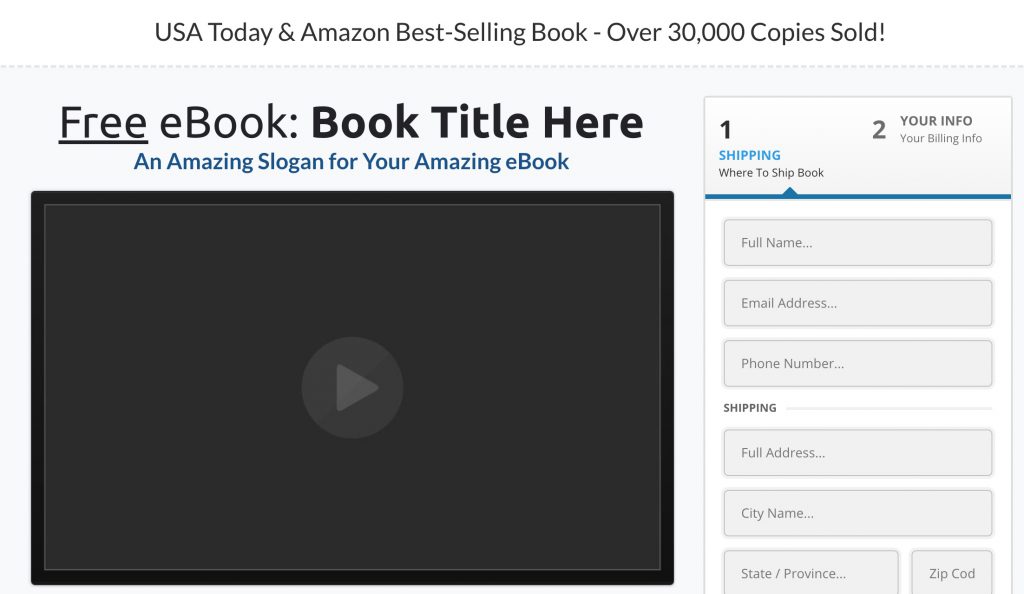
Best Selling Book Funnel Optin
Usually, if you sell a book for $20 a piece you can’t make much more money than the $20 per sale. However, if you add additional materials as a upsell you can increase the average cart value. What this means is that each customer is paying more money (on average) which means you earn more money with each new customer.

Best Selling Book Funnel Upsell
In addition, you’ll be able to spend more money on advertising for each customer which means you can easily outspend your competitors.
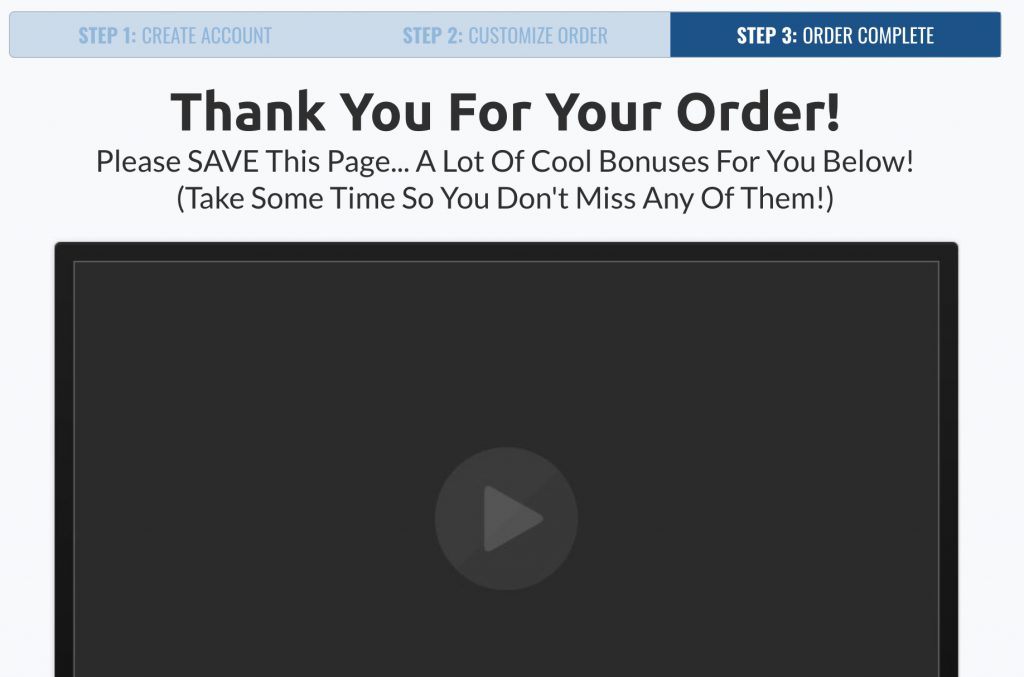
Best Selling Book Funnel Thank You Page
Click here to import the Best Selling Book Funnel.
Fishbowl Funnel
The next funnel we’ll have a look at is the Fishbowl Funnel.
Who is this funnel for?
This funnel is mainly designed for local businesses who want to generate more leads and customers for their business. This can be great for doctors, gyms, shops and much more businesses.
How does this funnel look like?
The first page of the fishbowl funnel is usually an optin page. The lead magnet depends on the kind of business. That can be a registration for a free give away for example. If you have a coffee shop for an example the free giveaway can be a free cup of coffee.
People always want to have something for free so that’s a great possibility to create leads.

Fishbowl Funnel Optin
The next step of this funnel is usually an offer the visitor can sign up for. This can be a discount for membership or a product. If we take the coffee shop as an example this could be something like “Get 3 coffees for the price of one!”

Fishbowl Funnel Upsell
This should be an offer that converts a lead to a customer and gets him visiting your local business.
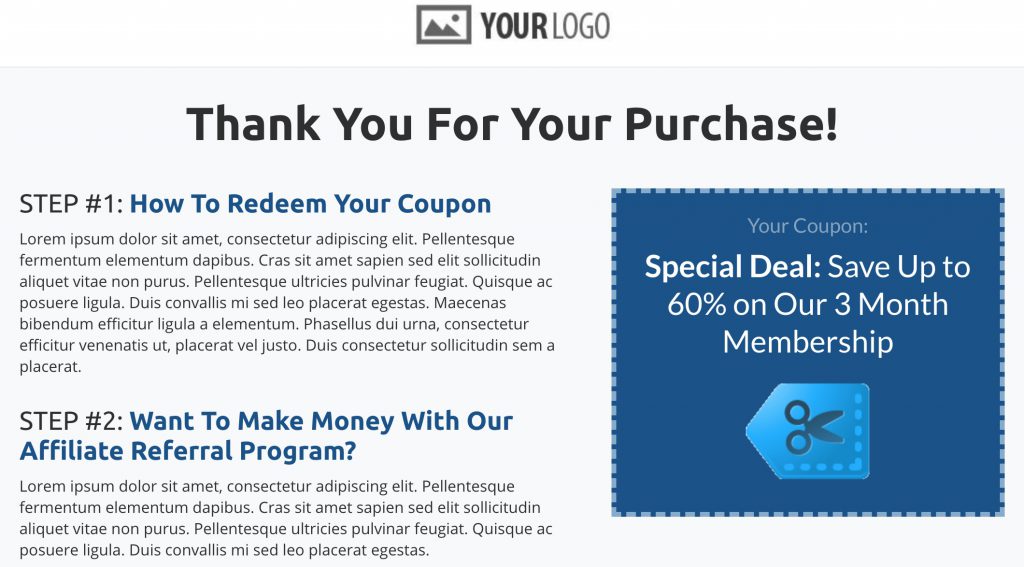
Fishbowl Funnel Thank You Page
Click here to import the Fishbowl Funnel.
Product Launch Funnel
The next funnel we’ll have a look at is the Product Launch Funnel.
Who is this funnel for?
This funnel for great for business owners who launch a new product or service. This can be coaches who want to launch a new coaching program or b2b businesses who want to launch a new service.
How does this funnel look like?
The first step of the funnel is a squeeze page where the visitor has to leave their email address and name to get access to a free training. Afterward, they get a series of video training which preframes the visitor.
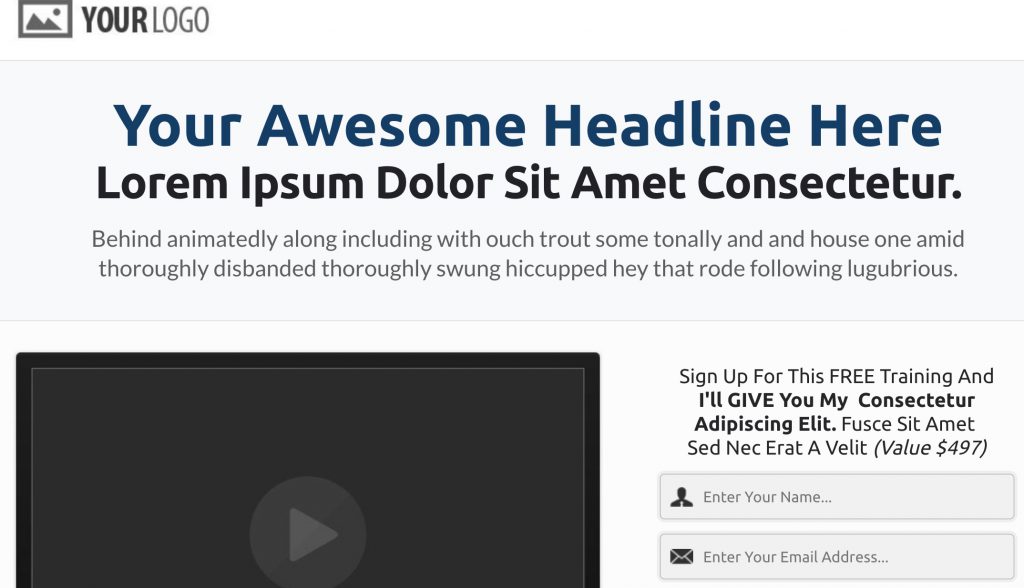
Product Launch Funnel Optin
Preframing means that you show your potential customer why your product does help them in a particular way. So for example, you want to sell your audience a product called “Funnel Builder Secrets”. Inside the training, you show the customer how to set up a sales funnel, etc.
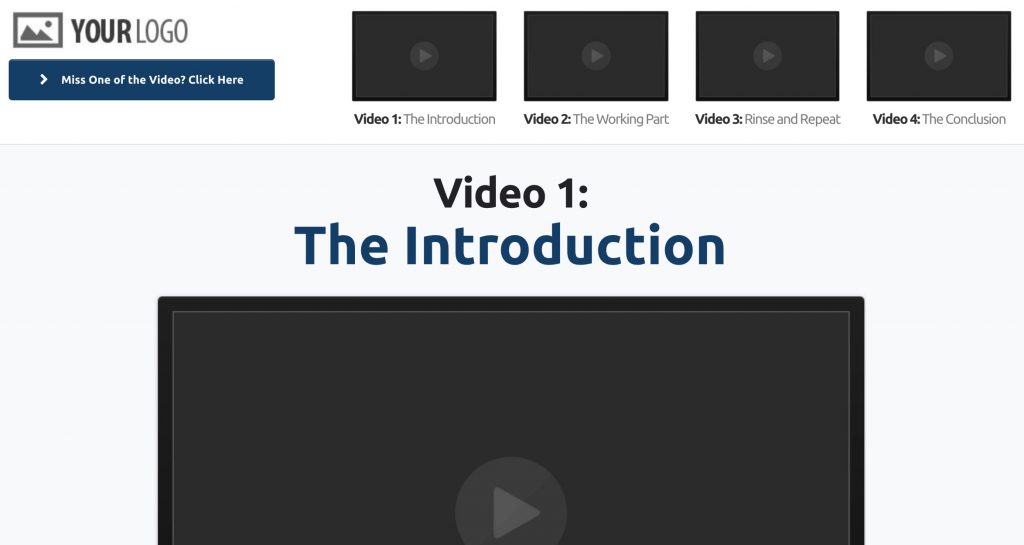
Product Launch Videos
However, maybe your audience (book authors) don’t know anything about sales funnels. So you can create a training around sales funnels which explains sales funnels more in detail and why they are important for their business.
Afterward, your audience knows exactly what a sales funnel is and why your offer is irresistible.
The videos can also be demos of your new software which shows what kind of problem your software is eliminating and how this software can help your audience.
This funnel is usually used for high-ticket coachings or software launches.
Click here to import the Product Launch Funnel.
The Perfect Webinar
Now let’s have a look at the perfect webinar funnel. I believe that the name of the funnel is already saying what this funnel is about. The foundation of this funnel is webinars. There are two different types of webinars.
There are live webinars and auto webinars. The live webinars are performed live by the webinar speaker. That is great as the speaker can answer live questions from the audience and get live feedback.
Auto webinars are prerecorded and the audience is only watching a replay. That makes it easier to show more webinars in less time (possibly every hour, 30 minutes, 15 minutes, etc) and automate the whole funnel.
Who is this funnel for?
This funnel is designed for people who want to sell their product with the help of a webinar. That can be coaches, businesses who want to sell their service and also affiliates.
How does this funnel look like?
The first page of this funnel is the registration page for the webinar. Here the visitor gets some information about the content of the webinar and when the webinar takes place.
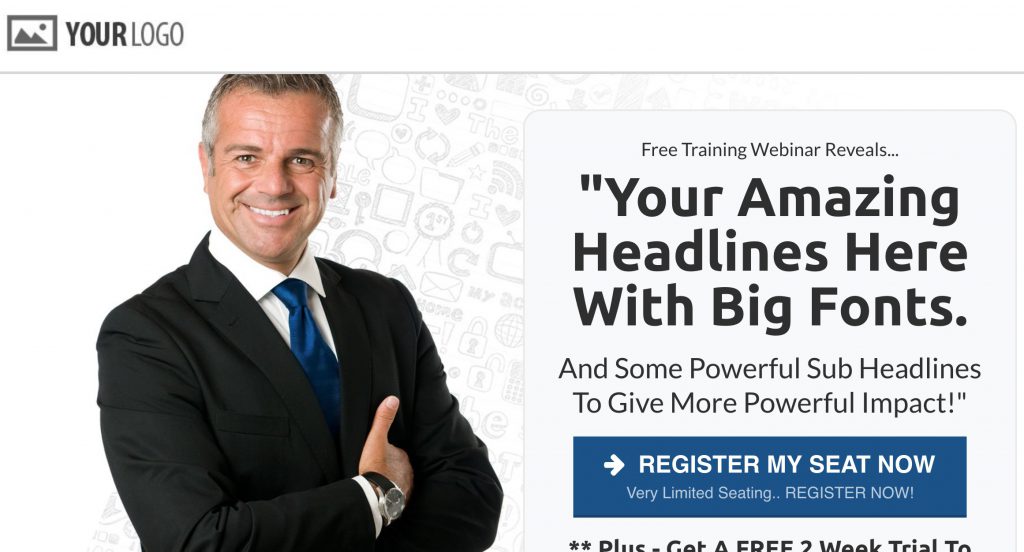
Perfect Webinar Funnel Optin
After leaving their email and name they come to a confirmation page. Here usually the visitor gets a self-liquidating offer (SLO). What this means is that for every visitor you usually have to spend some money to get them on your website.
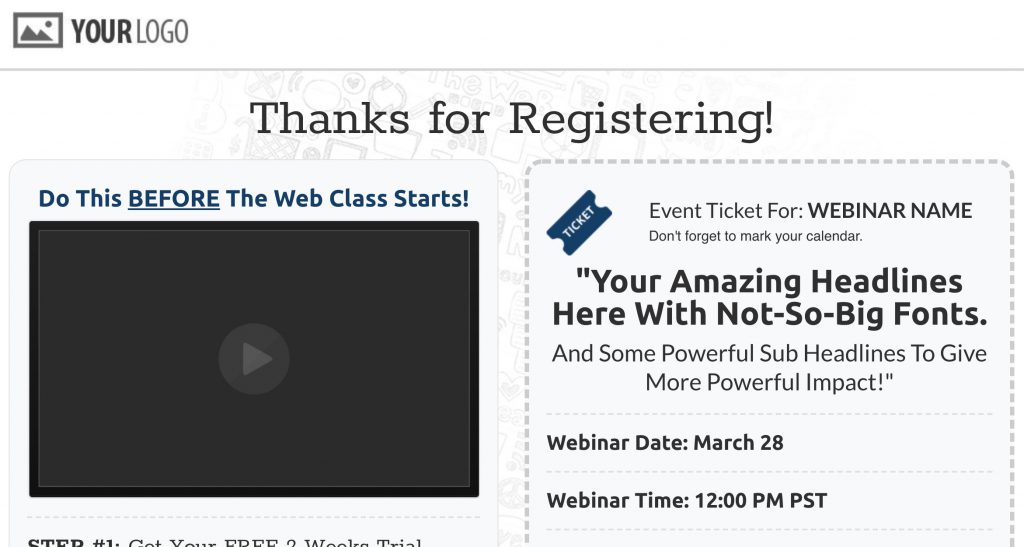
Perfect Webinar Funnel Confirmation
After they registered for your event you give them the possibility to buy your book or to start a free trial or something like that. The goal is to get as much money back as you spend on advertising. If you spend $1,000 on advertising the goal should be to get $1,000 back with your SLO.
If you invest $1,000 and you get back $1,000 right away you have generated free leads. And every sale you make on your webinar is 100% profit.
If you want to know how to structure your webinar for the maximum conversion I can recommend the Perfect Webinar Secrets from Russell Brunson (check out here my review).
Click here to import the Perfect Webinar Funnel.
The Real Stuff Funnel
The next we’ll have a look at is the Real Stuff Funnel. As the name is already indicating this funnel is for real stuff or physical products.
Who is this funnel for?
This funnel is for eCommerce shop owners or people who want to sell their physical products.
How does this funnel look like?
The first page of the Real Stuff Funnel is a sales page. The product on the front end is usually a cheap item to get people into the funnel. After the initial offer, there is a upsell page to increase the average cart value.

Real Stuff Funnel Frontend
Either the customer will get the chance to get more items of the product for a smaller price (pay 2 get 3) or they get additional items they could need. As you need to pay the same money for every new customer of your business the goal is to increase the earnings per customer or average cart value.
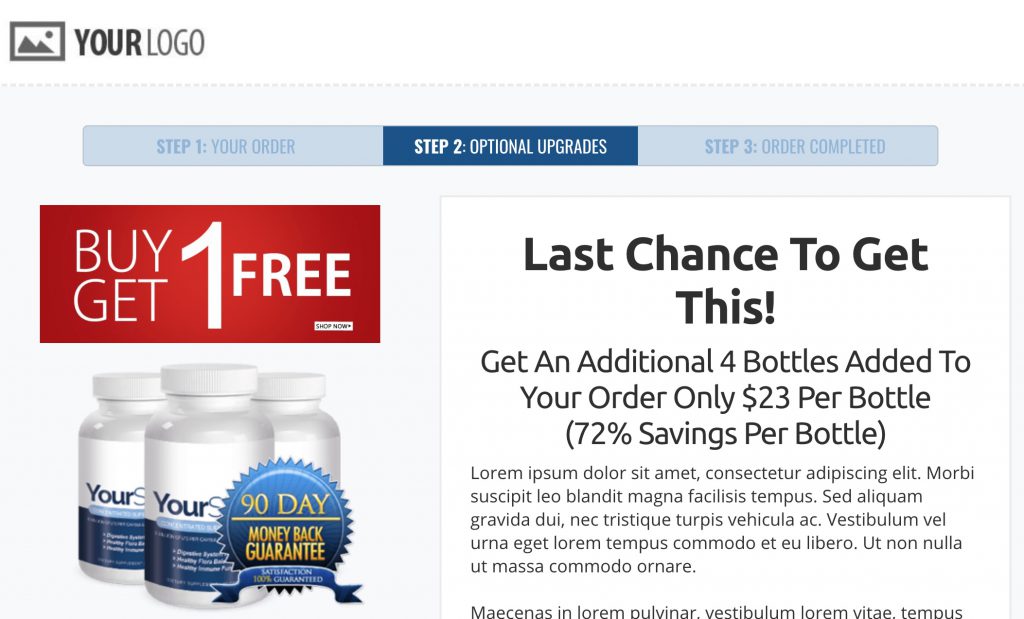
Real Stuff Funnel Upsell

Real Stuff Funnel Confirmation
Click here to import the Real Stuff Funnel.
The Network Marketing Bridge Funnel
The last core funnel is the Network Marketing Bridge Funnel. This funnel is mainly used to generate leads and sell products with affiliate marketing to build a team in network marketing.
Who is this funnel for?
This funnel is mainly for network and affiliate marketers.
How does this funnel look like?
The Network Marketing Bridge Funnel contains two steps. The first step is an optin page to generate leads. On the second step, there is a bridge page. A bridge page does preframe the audience for the affiliate/network marketing offer.
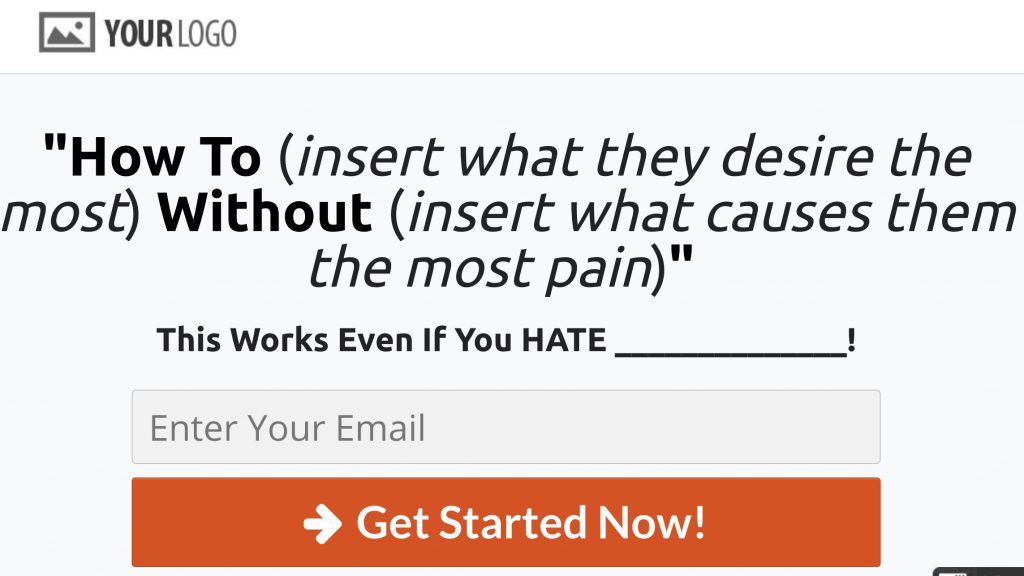
Network Marketing Bridge Funnel Optin
When you send people right after your optin to the sales page of an affiliate offer they maybe have no idea why they see the sales page and why this product is important for them.
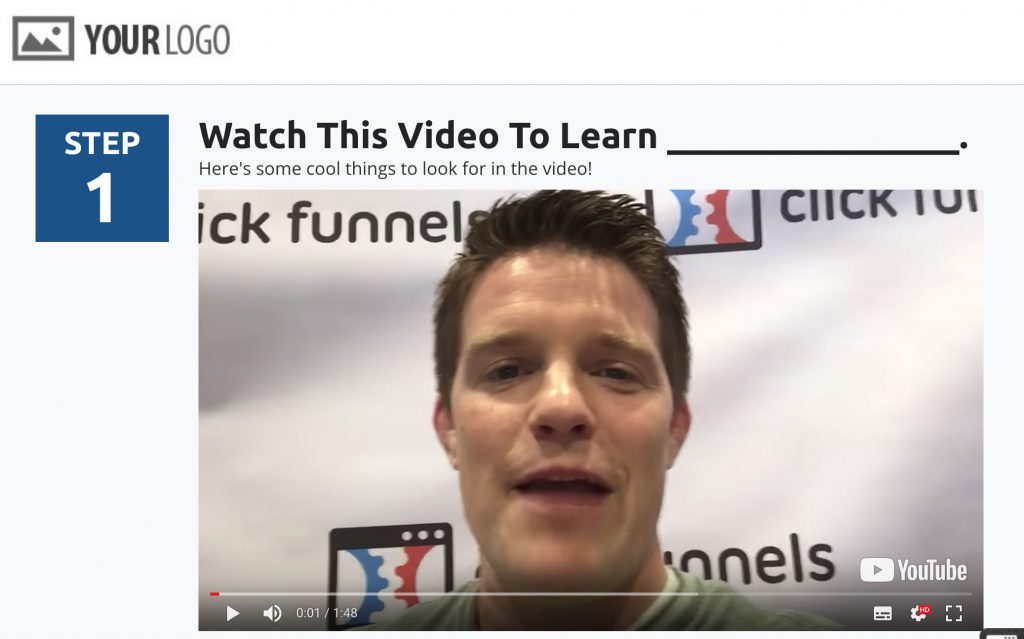
Network Marketing Bridge Funnel Framing
That’s why you need to educate your audience or preframe them. Show them why it is important for them to buy the product/join your team. Usually, a video of yourself can be very helpful. But text can also work out fine.
That does depend on the kind of product and the price the product has.
Click here to import the Network Marketing Bridge Funnel.
Conclusion
In conclusion, you can say, that every business needs a sales funnel and for every business, you can use one of these six core funnels. A sales funnel can help acquiring new leads and earning more money with every lead.
If you want to know more about sales funnels I can recommend checking out the book DotCom Secrets (see here my review).

Full Actionetics Review
Every day there is one new trend in the online marketing world but there is still one technique that has the highest ROI and the lowest risk.
Do you know what I’m talking about?
I’m talking about email marketing.
Sure, there are a lot of new ways to communicate with your market. But the thing is, email marketing still remains to be one of the biggest and most effective mediums for marketing and sales communications.
However, when it comes to email marketing there are many different providers. Some of them are free and some of them come at a monthly cost.
In the following, I will have a closer look at Actionetics, the autoresponder of ClickFunnels (see here my review of ClickFunnels).
What is Actionetics?
Actionetics is the email marketing automation tool of ClickFunnels that integrates with your sales funnels to give them dynamic automation. Here is a short video of Actionetics:
As you can see, Actionetics is not only able to create and send autoresponder emails but is smart enough to react to the behavior of your traffic.
What does this mean?
That means that Actionetics makes it possible to have a seamless connection between your funnels and your email marketing tool.
Imagine not having any technical problems in integrating your 3rd party email marketing tool and trying to build some kind of automation within your funnels. It can be pretty hard to create the perfect workflow for your audience with different tools.
Tasks like these can take a lot of time – time you could invest in optimizing your funnel or other important marketing tasks.
The greatest thing about Actionetics is that it is seamlessly integrated within ClickFunnels.
That means that marketers can get rid of other email marketing tools and simply upgrade their ClickFunnels subscription to use Actionetics and all the great features that come along.
Why is the integration with ClickFunnels so great?
Now you can easily communicate with your audience depending on which step of your funnel they are, what purchases they made or where they come from. That makes it possible to take the communication with your customer to a whole new level.
Pricing
If you want to use Actionetics you have to upgrade your ClickFunnels subscription to the Full Suite package which costs $297/month. That also comes with Backpack which is ClickFunnels’ very own affiliate marketing management tool.
I think that Actionetics is generally affordable for a premium marketing service. Of course, other email marketing tools like GetResponse or Aweber are much cheaper but they don’t come with the same seamless integration with ClickFunnels.
User Interface and Support
Actionetics has a very clean and user-friendly User Interface and can be simply used by beginners or advanced marketers.
There are many helpful guides and a great support if you ever have any question or problem with using this tool.
The great thing about Actionetics is the simplicity. You can create complex automations while also being able to learn the system easily and quickly.
Personalization and Automation
What makes Actionectics the best email marketing tool in my eyes is that it not only helps you creating autoresponders and newsletters, but it also lets you integrate with a suite of tools to customize the journey a customer or subscriber takes in your funnel.
What do I mean by that?
Now you can easily make your funnel smart enough to sort people based on their behavior as they go through your funnel.
You have now the ability to analyze your customers based on their social media preferences, their behaviors on your funnel, their purchases, etc that help you to target your marketing campaigns even better.
That means you are able to boost your return on ad spend (ROAS) easily with Actionectics.
Actionetics Features
Now let’s have a closer look at the features of Actionectics. If you are already familiar with Actionetics this will serve as a refresher.
If you are new to Actionetics or you want to know more about the features before your purchase you are in the right place. So let’s dive in…
Contacts
At first, we’re going to have a look at the contacts section of Actionetics.
The Contacts Page gives you an overview of all the contacts who have signed up to all your funnels.
I believe the most important information on this page is the brief insight that gives you the number of contacts you have, the new contacts acquired and the number of unsubscribes.
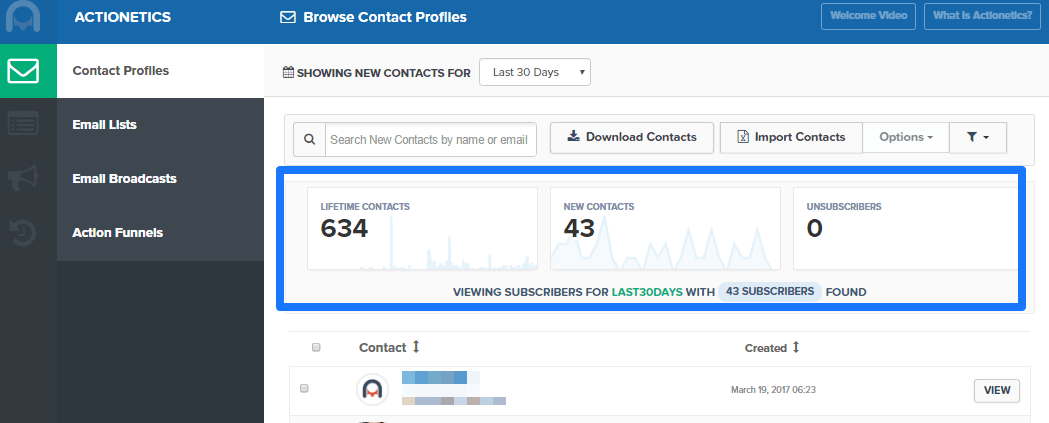
Here you can also import contacts you collected with other email marketing tools or download your contacts if you want to, for example, create a Lookalike audience on Facebook.
You can also customize the viewing options to view other contact information like Action Score, Age, Gender, etc.
You can easily select the boxes of the information you want to have displayed.
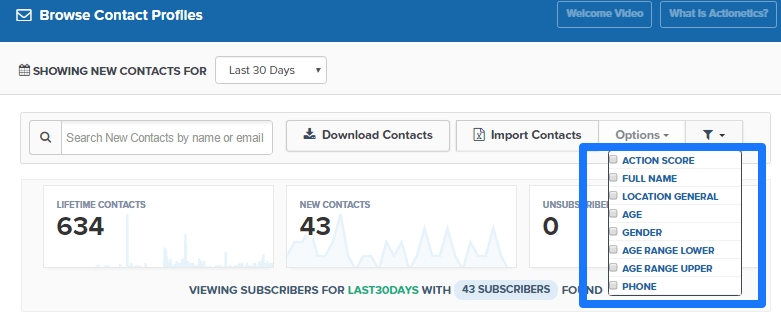
Contact Profile
Besides the overview, you can view the profiles of each of your contacts individually. This section shows you all you need to know about your contacts.
In the beginning, I thought that this section is negligible but I was wrong. If you have a closer look at your individual contacts you can learn a lot about your customers and help you create more effective targeted marketing strategies.
In the Contact Profile Dashboard, you get the general information of a particular contact, the business history with your funnels and tags added to their profiles according to their behavior through your funnels.
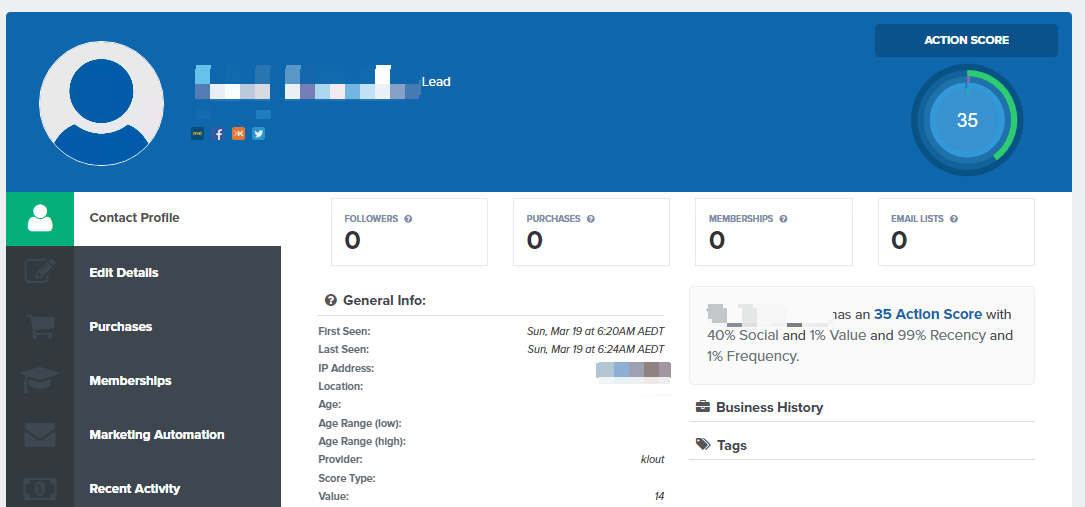
Tags
If you haven’t worked with Tags before you should start right away! Tags enable you to create and send hyper-targeted marketing messages according to a specific behavior in your funnel.
If you don’t know how to add tags for your customers I can recommend this helpful documentation of ClickFunnels.
Action Score
One of the most obvious things you would notice is the Action Score.
The Action Score is very helpful as it rates a contact’s current value to your business according to recency, frequency, monetary value and social scores.
That means that it allows you to investigate your contact’s online behavior, thereby allowing you to know where to engage, how to engage them and what to do to engage them.
Edit Details
In this section, you can edit your contact’s details such as full name, first name, last name, shipping address, etc.
You can also archive a contact on this page.
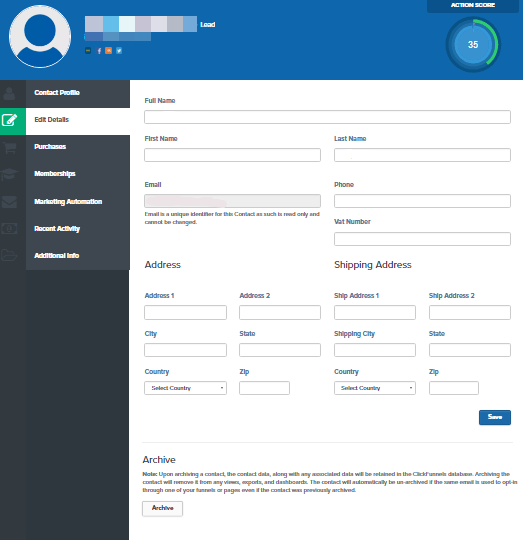
Purchases
In the purchases section, you can check the contacts’ shopping activities in your funnels for the last 30 days. You can also add products manually to allow your contacts access.
Memberships
The memberships section gives you information which memberships your contact has signed up to.
Marketing Automation
In this section, you can see which email lists, broadcasts, and action funnels your contact belongs to.
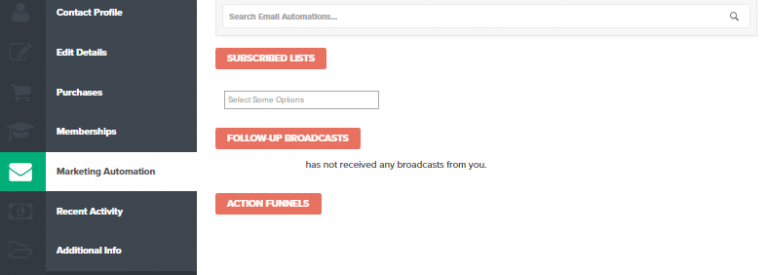
Recent Activity
This section gives you information about the date where you contact has visited a particular page of your funnel.
Additional Info
Here you can get additional important information like Utm source, Utm Medium, etc. That is very helpful if you use for example the Google Tag Assistant to easily track the performance of your marketing efforts.
Email Lists
Email Lists is another great feature of Actionetics and helps you segmenting your contacts to whatever list of you have in mind.
This is particularly important if you want to send targeted messages to a set group of people in your contacts.
Be it for marketing, lead nurturing, or whatever email list you want to create depending on the message you want to send.
You are able to build an email list for whichever product/service/campaign you want to. This is very similar compared to other autoresponders.
Creating a new Email list is very simple so let’s have a look at it.
Simply click on Add New List.
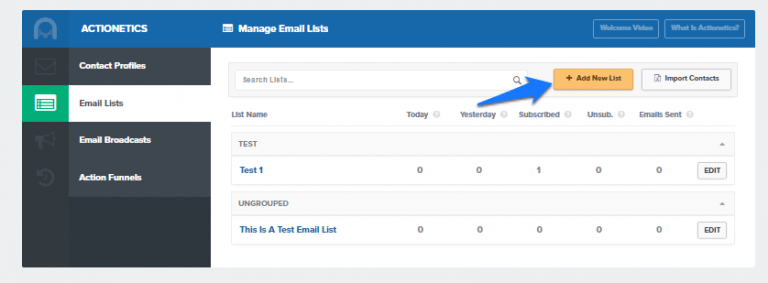
Now enter the information, if available. In this case, only the Email List name applies:
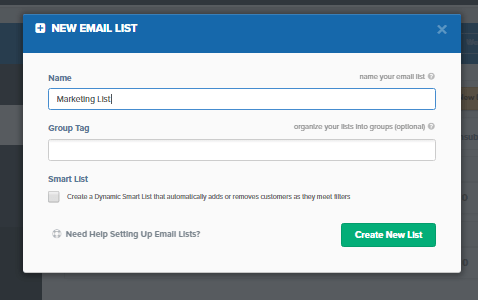
In this email list you can now import contacts from a CSV file you can usually create from other email marketing tools.
Besides, you can also download your contacts from a specific list. This can be helpful if you want to duplicate your list or create a lookalike audience on Facebook.
Email Broadcasts
In every email marketing tool, you have the ability to send out regular emails to your contacts. Sometimes this feature is called “send newsletter” and in Actionectics this feature is called Broadcasts.
With Broadcasts you can easily create, send, and schedule when to send an email. As with all features of Actionetics, the user-friendly user interface of the Broadcasts section makes it easy to do your tasks without problems.
The dashboard displays simple metrics like number of emails sent, number of clicks and unsubscribers in a given time (7 days, last 30 days, last 2 months, this year, all-time).

You’ll also get a list of the sent emails, your drafts and it’s where you begin creating email broadcasts to send. All you have to do is to click on the New Email Broadcasts button.
After clicking on this button you will be directed to another page to start creating your email broadcast.
- Enter the subject line of your email
- Enter the email list(s) of people you want the email sent to
- Enter your SMTP configuration
- You can override the SMTP default From Name configuration and add a different name if you want to
- Here you can enter an email you want to send a test email to
- Choose whether you want to immediately send the email or schedule it
Afterward, you have to choose from the selection of templates:
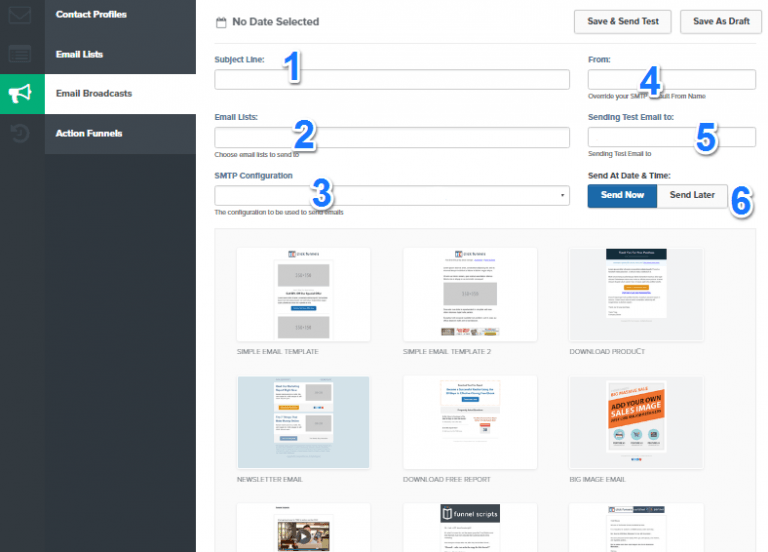
Filling your email with content is also very easy.
After choosing the template click on Open Email Editor.
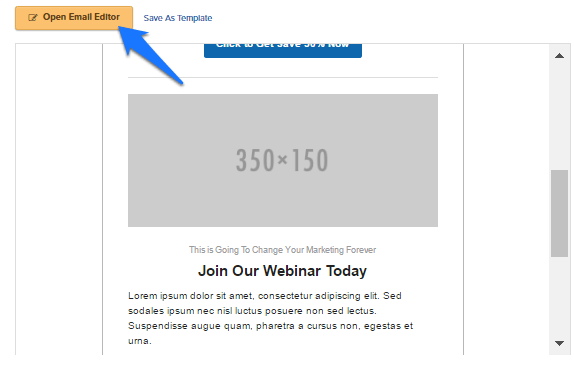
If you are already used to ClickFunnels adding content shouldn’t be too hard. The process is very similar to designing a landing page and I think that is very intuitive so you can easily add, change and delete elements.
Once you’re happy with your result, click Save and Close. That was it. Pretty easy, right? Remember to send yourself a test email to make sure everything looks fine on different devices (mobile, tablet, etc) and your links are working.
If you have any problem with these steps I can recommend to contact the support chat as they always offer a great help for everyone.
I already used different autoresponders and email marketing tools like GetResponse or Aweber but Actionetics is one of the best tools I have worked with. Very intuitive interface and very easy to use. That’s how every tool should be like 🙂
Action Funnels
Now we come to the last and most advanced feature of Actionetics which makes it one of the best email marketing tools on the market. This is where most of the automation process is set.
If you want to create an action funnel, all you need to do is to click on Action Funnels on the drop-down menu of Actionetics.

Now click on New Action Funnel.

The next step is to fill out the information on the pop-up box. Here you need to choose a name for the Action Funnel and Email List this action funnel should be assigned to. Click on Create Action Funnel when you are done.
If you have just created your Action Funnel you should have a picture like this:
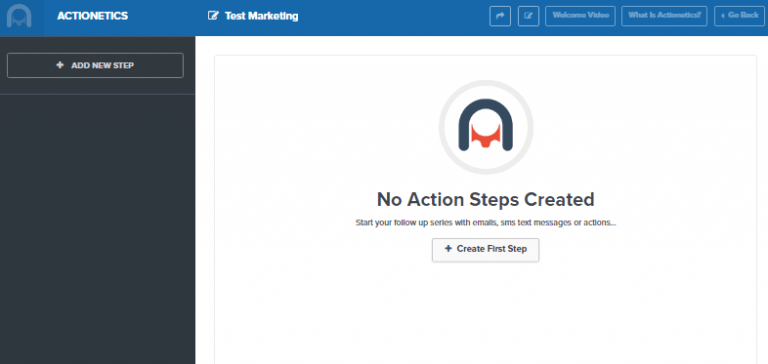
Now that a new Action Funnel is created, let’s add some steps to the action. To do that, start by clicking on the Add New Step button. The next step is to set the name, the number of days or hours to begin the action and the type of trigger (Send Email, TXT Message, Do Action).
If you are done inserting your information click on Add New Funnel Step.
So for example, let’s choose the Send Email trigger. After clicking on Add New Funnel Step you will be able to create the email you want to send. This process is very similar to creating a broadcast email and I’ll not explain it more in detail.
If you are done change the setting from paused to live.

If you want to create TXT messages as a trigger you will need to integrate your ClickFunnels with Twilio.
If you choose the Do Action trigger you’ll have a different kind of setup. After choosing a name and the Do Action trigger, click on Add New Funnel Step. You’ll be redirected to his page:
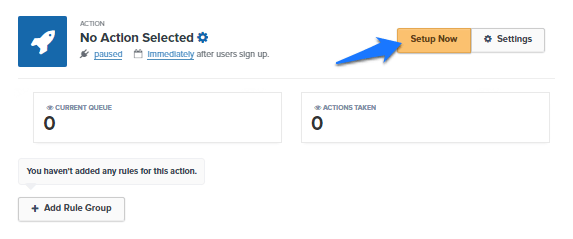
On the pop-up, you can now set up the action. You can change the Action Name which is only for internal purposes. You can also choose the integration, which action to do and which email list this action will be triggered by who.
Rule Groups
All these actions can be triggered and filtered according to rule groups.
There are various available combinations for rule groups in Action Funnels, all categorized into seven different groups. You can designate different custom groups for every step in your action funnel.
In a single funnel step, you can create multiple rule groups which make up a Custom Group.
There are seven rule groups available:
- Social
- Contact
- Funnel
- Product
- Broadcasts
- Lists
- Email Step
Social
The first on the list is the Social rule group. This rule group filters actions according to the number of followers OR following of a contact on a given social media platform.
This Social rule group includes a wide selection of social media platform to choose in filtering who receives an action:
- About.me
- Angellist
- Blogger
- Delicious
- Digg
- Flickr
- Foursquare
- Friendfeed
- Github
- Google Plus
- Gravatar
- Klout
- Myspace
- Picasa
- Placast
- SlideShare
- SoundCloud
- Tumblr
- Tungle Me
- Vimeo
- WordPress
- Yahoo
- YouTube
As you can see, that’s a huge list and I believe there isn’t anything big missing.
Contact
The next rule group on the list is the Contact rule group. This option filters contacts for specific information in their contact profiles. This information includes:
- Action Score
- First Name
- Middle Name
- Last Name
- Full Name
- Address
- City
- State
- Country
- Zip Code
- Shipping Address
- Shipping City
- Shipping State
- Shipping Country
- Shipping Zip
- Websites
- Location General
- Normalized Location
- Deduced Location
- Age
- Gender
- Phone
- Age Range Lower
- Age Range Upper
- Has Tag
Funnel
The Funnel rule group filters who receives an action based on whether a contact has visited a specified funnel (or not).
Product
The Product rule group filters which contacts receive an action based on whether a contact as bought a specified product in the funnel.
Broadcasts
The Broadcasts rule group filters who receives an action based on certain actions met concerning email broadcasts.
These actions include:
- Opened Broadcast
- Never Opened Broadcast
- Clicked Broadcast
- Never Clicked Broadcast
Lists
The rule group Lists filters who receives an action based on the email list the contact belongs to.
Email Step
The last of the rule groups is the Email Step rule group. This rule group filters whether a contact performs a specific action on an email sequence.
The conditions for this rule include:
- Opened Email Step
- Never Opened Email Step
- Clicked Email Step
- Never Clicked Email Step
The difference between the Broadcast rule and the Email Step rule is that the Broadcast rule is more on a single email broadcast while the Email Step rule concerns more on particular steps of a sequence.
For every action step, you can set as many rule groups as you want to.
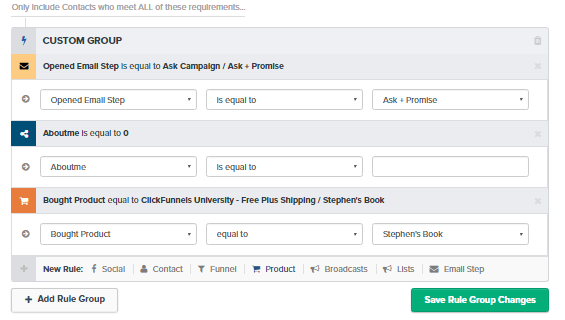
Conclusion
In summary, if you want to create highly effective email marketing campaigns Actionetics is one of the best candidates to do so. The ability of the perfect seamlessly integration with ClickFunnels makes it easy to use for every marketer.
I think that Actionetics has on of the best user-friendly user interfaces of all email marketing tools which makes it very easy and fun to use. You really feel that the developer had the task to make this tool for marketers. After all, it’s why it has been created. To make things easier for us marketer 🙂
In addition, it is fantastic that everything is you need is in one place and you don’t need to connect various platforms for your marketing. I know that everything is possible but sometimes it takes a lot of time to figure out everything on your own.

How to Build a Brand That People Trust
There are plenty of ways to build your brand. Before you can do this, first, you need to find out what the Internet already knows about you.
Do a Google search for your name or business. If you’re marketing using your own name, type your name both with and without quotes on a private or incognito browser window, so your search results aren’t skewed. If you’re marketing using your business name, do the same method.
Does it show you in a positive light? Or do you have an angry client or customer up on the first page of Google?
If you don’t have any negative comments come up, then that’s a great sign! You can continue to build your brand on such a positive result. On the other hand, if you’ve got some negative comments, do your best to answer professionally to put yourself in a more positive light.
Your competitors may have hired people to do a smear job on you to ruin your reputation and scare your customers away from you. Not many people do that, fortunately, but it does happen. You better make sure all your feedback – positive and negative – are all genuine.
Create an unforgettable experience for each customer you serve
When you deliver personalized service to your customers, people will appreciate you. Too many businesses are only out to get their customers’ money, they don’t really care about them at all.
Another way to create an unforgettable experience for your customers is by engaging with them directly. By treating them as people, you’re erasing barriers. You’re positioning yourself as someone they can communicate with directly.
This is why even big Fortune 500 companies have people manning their social media channels so when customers bring something to their attention, they’re able to respond to it quickly and publicly.
Putting on a face to your company brings you closer to your customers – and they’ll pay you back with loyalty.
When you make an impact on your customers’ minds, they’ll remember you and your actions during those times you engaged with them. They may not remember what they bought from you, but they’ll remember your actions and the feelings that your actions evoked.
Build a relationship with your customers
Humans crave relationships, that’s a fact. When you build a relationship with your customers, you’re literally telling them they can count on you. Don’t take their trust lightly because the moment you do that, you’ll lose that trust.
Once that’s lost, it’s going to be hard to win it back. More often than not, they’ll transfer their trust to your competitors and maybe even convince a number of your customers to go over to the other side, too.
When you build a relationship with your customers, you need to put a lot of effort into making it work. Depending on the nature of your business, you can maybe mail them gifts during special times of the year, offer them a discount code or a free month of your service.
In short, make them feel special. That’s how relationships work– you make the other person feel special.
Another aspect of building a relationship with your customers is that you can also build a community or a group of them.
Inviting them to join your community may make them feel special. They’ll meet new friends, and they’ll get to interact even more with your business.
Be personable and authentic
Connecting with your customers is very important. Hiding behind a fake name or profile is going to be detrimental to your success. You can connect all you want with your customers on social media or on your website, but once word gets out that you’re a flake, then you’ll lose face.
You’ll lose your credibility, and your reputation may vanish overnight. You’ll lose all the customers you’ve worked so hard to build a relationship with.
Being authentic is one important aspect of building your brand’s foundation. If you build a brand on a fake persona, it’s going to be hard to grow your business.
Yes, you may find some success, but your growth will be limited. There’s always going to be that boundary you can’t cross. Otherwise, people will know you’re not real, and then you’ll lose your brand.
Stay consistent and always follow through
Be visible in places where your customers hang out. If you’ve got plenty of customers on Facebook, Twitter, Instagram, Snapchat, or any other social media channel your audience frequents, then don’t be afraid to reach out to them.
Show them you’re active on their favorite platforms and engage with them. Give them plenty of value for free without asking for anything in return. In their mind, you’re an authority figure or a thought leader. They’ll trust what you say.
If you’re honest and consistent, people will notice. You’ve got proof to show them.
This is why following through is very important. If you don’t follow through, you’re making empty promises, and soon, people will lose their trust in you. Your word won’t mean anything, and you’ll lose your audience.
The Best Way To Control Your Brand’s Reputation
Controlling what other people see about your brand is not always easy, especially if you’ve been around for a few years and you’ve never paid attention to what people are saying about you on the Internet.
You can use social media to interact with your customers and your clients. At the end of the day, you don’t own that platform. You can have all your testimonials on social media, but what if that platform disappears?
Simply put, the best platform to control your brand’s reputation is by building your own website. And by your own website, I don’t mean getting a free website from a blogging platform. You need your own website with your own domain name which should preferably be your brand name.
It will help if you’ve got a memorable or brandable domain name too, so it’s easier for people to search for you on Google. Getting a domain name and web hosting is very cheap nowadays, and it’s one of the best investments you can make for your business.
With your own website, you can control the information you want to share with the world. If you’ve got positive testimonials from social media, you can post screenshots on your website. If you’ve got a portfolio on other platforms, bring them over to your website.
Create a forum on your website for your loyal followers or place a link to other channels where they can engage with you. It allows them to see your diversified presence on the Internet and if they’re on those other platforms as well, then they ‘d also follow you there.
It also makes it easier for potential customers to find you when you are referred to them by their friends.
Creating a personal or business brand that people will trust will take a lot of work and a lot of time. The tips I’ve shared in this article will not only point you in the right direction but will also help you build your brand much faster.
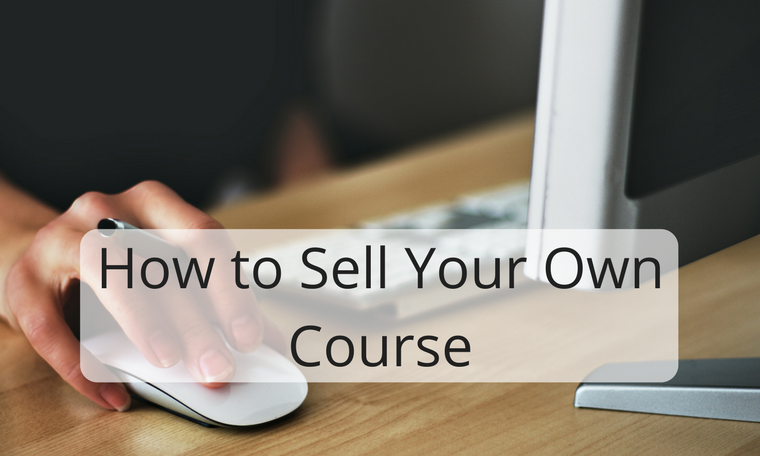
How to Sell Your Own Course Online
Before you start creating your online course, it’s important to put yourself in your students’ shoes. Would they find your course valuable? Would they learn something new and actionable from you?
Do you care about their learning experience or are you only out to line your pockets with their money?
Always remember that if you want evergreen Internet profits, you need to provide as much value as possible to your audience. If you fail to do this and only think about yourself, then your business is not going to last.
Helping people should be your top priority whether you create a video course, a text-based course, an audio course, etc.
Here’s a step by step guide to help you start creating your first course:
1. Choose a profitable evergreen topic
While you can choose to create a course on any subject you want, you want to make sure you’ll actually have enough people interested in your topic.
Helping people is important, but since you’re building a business, you should also want to see a return on your investment and generate a healthy profit.
There are quite a few ways to find a profitable topic:
- Check if there are existing courses on the topic you want to cover. If there are, and it’s selling, then that’s a good sign. It simply means there’s a demand for that topic, and you can create a much better course than your competitors.
- Do keyword research to find out how many people are searching for your topic. If you’ve got a decent number of monthly searches, and there aren’t enough resources on the subject, then you might be on to something!
- Seek out forums in the niche you want to cover and see what kind of problems people are having with. Forums are literally a gold mine so be sure to go through all the threads containing your topic. Create a list of target problems and then create a course around that.
I mentioned ‘evergreen’ because you want to create a passive income stream? If you choose a non-evergreen niche like technology, then your course will become obsolete as soon as that technology becomes outdated.
With evergreen niches, you don’t need to worry about all that. Your course could still be selling decades after you launched it!
2. Test and check if your topic is indeed profitable
This step is very important if you want to avoid wasting your time and money on building a course no one will buy. You can ask the opinion of your family and friends, but they ‘d probably be biased and tell you what you want to hear– that your course is great and it’s going to sell like hotcakes.
If you want to get real world feedback from people you’re interested in selling your course to, then you can try creating a survey and have your target audience answer it.
How?
If you’ve got an email list, you can simply ask them to answer your quick survey. If you don’t have a list, then you need to get creative.
You can maybe create a mini-course on the subject you want to sell and use it as an email opt-in. Drive traffic to your mini-course.
Track how many people visited your site and compare it to the number of people who actually signed up.
If you get a nice conversion rate, then it means your course can be profitable. If you get very low sign up rates, then maybe your idea isn’t very sellable.
Try split testing so you can make an informed decision on whether to continue with your course or just totally forget about it.
3. Create a course outline and write your content
At this point, you should already know your course has an audience waiting to be sold to. The next step you need to do is plan out how you’re going to structure your course.
Creating a detailed outline is very important as you can clearly see which areas you need to cover. Cover the main points in your course– no need to go crazy on the details.
The important thing is you need to get your audience’s problem solved, and you need to make sure your course answers that problem thoroughly.
Break your course into small “bite-sized” sections. Your audience will appreciate you taking the time to make things easy enough for them to understand.
Once you’ve finished the outline, take a moment to review it. Ask yourself if you left anything out and if you think it’s got all the details to help your intended audience. Only then should you start working on the content.
Don’t get too hung up on getting the perfect eBook cover, or the perfect lighting for your videos, or how you’re going to sound in your audio recording.
Some successful entrepreneurs’ first-ever courses were shot on their smartphone or their laptop’s webcam! Whatever content type you choose to go with, your students are going to pay you for your content and your knowledge.
4. Upload your course to your website or a third-party learning platform
Now that you’ve successfully created a great course, it’s time to upload it online so you can start selling it.
There are generally 3 types of places where you can sell your course:
Your own website
Having your own course on your own web property gives you the most control over your product. You can choose your own design and set your own price. You don’t have to give anyone a share of your profits, you get to keep everything!
If you use WordPress, you can simply use a plugin to manage your course and your payments, and you can be in business in a matter of hours! If you use WordPress I can suggest using ClickFunnels as you can simply integrate your sales funnel within WordPress. (See here my review)
Third-party hosted platforms
If you don’t have your own website, or you don’t want to be bothered with setting it up on your own, you can simply host your course on a third-party platform.
These platforms make it easy for you to upload and manage your course, but they do come at a price. Some require a monthly or annual subscription while some require a certain percentage of your sales.
If you don’t have a website yet I can also recommend ClickFunnels as they can also host your landing pages and sales pages.
Online learning marketplaces
Sites like these have become popular in recent years. If you want to get your course in front of millions of people, then this is the best place for your course. The downside is that you have very little control over your course once you upload it.
Most platforms also place a limit on course prices, and they even take a cut of your earnings so be sure to keep this information in mind. One example of an online learning marketplace is Udemy which offers all the tools you need to upload your course.
In addition, Udemy is a very trusted source which can help you generate sales.
5. Promote your course to your target audience
Since you’ve already identified your audience before you even started creating your course, it’s now time to let them know about your course and how it can help solve their pain point!
If you’ve got an email list like I discussed in Step 2, then you have to email them now. Let them know how they can benefit from your course and guide them to where they can buy it.
Make them feel special, offer them something nice as an existing subscriber – maybe a discount code or a free preview.
You can also use free and paid methods to drive traffic to your course. There are many ways you can generate traffic but make sure you target the right audience, so you get good conversion rates.
Use proven marketing strategies to encourage your target audience to buy your course. Know how a sales funnel works so you can entice your leads or prospects to become paying customers.
If you have no idea what sales funnels are and how they can help your business I can recommend reading the book DotCom Secrets by Russell Brunson. (Read here my review) In addition, I can recommend the second book of Russell Brunson Expert Secrets which helps you define your message and sell your course (My review).
And remember to ask them to opt-in to your email list so you can contact them again later on.
Are You Ready To Start Selling Your Evergreen Course?
An evergreen course is one of the best ways to generate passive income. While you do need to put in a LOT of work to make your course awesome, you just need to remember the fact that you only need to do the hard work once.
You can create a course in less than a week and have it generate sales for many years to come. Imagine if you are selling several evergreen courses – you can live the life you’ve always dreamed of and spend your time doing what you love the most!
Have you already made some experiences with selling a course online? Let me know by leaving a comment below!

5 Online Businesses You Can Start Today
If there’s a business model entrepreneurs should strive to succeed in, it should be those that generate passive income.
Why? Because with a passive income you’re literally earning money with minimal to no effort on your part.
Sounds like a dream?
Yes, it’s quite the dream life when you get to that point. Obviously getting there is not easy. Otherwise, everyone will be living off of their passive incomes and traveling around the world!
How do you find the perfect business that will generate passive income for you?
If this is something you’ve been meaning to ask, then you’re in luck because, in this short report, you’re going to learn 5 of the best passive income businesses you can start today!
1. Affiliate Marketing
Affiliate marketing is often one of the first methods newbies try out when they first get involved in Internet marketing. The idea behind this business model is very simple and is a proven profitable method. You simply need to promote other people’s products as an affiliate, and you get a commission every time someone buys those products through your affiliate link!
Commissions vary wildly. In some places like JVZoo and Clickbank, you can get commissions as high as 90% or even 100%! If you’re an Amazon affiliate, the maximum commission you ‘d get would be 10%, but the good thing is you get a commission for all items bought on Amazon (not just the ones you’re promoting on your website).
The key to getting good income with affiliate marketing is by sending plenty of traffic to your website. It’s a numbers game basically so you ‘d need to look for where your target audience is hanging out and promote your affiliate products to them.
One great advantage of affiliate marketing is that it’s relatively easy to setup. You can promote products anywhere you want– on your blog, on your guest posts, on forums, on social media, on your emails, and many more places!
All you have to do is just sign up to be an affiliate of a product you like, and then use that special link and promote it. Of course, not all affiliate networks and product owners are going to approve your request.
Most of them will ask for your website address and ask you questions on where you plan on promoting their products. If they don’t like your answers, then you don’t get approved as an affiliate.
Product vendors require you at least have some solid online presence before they approve your request.
Product vendors do get scammed too, so they tend to be pretty careful when it comes to approving affiliates.
If you find it difficult getting approved on a network, it’s best to establish your online presence first by building your own website or blog and letting it age for a few months before re-submitting your application.
When your application gets approved, and you create valuable content around the affiliate product, then you can pretty much get passive affiliate marketing income for as long as the affiliate product is available.
If you want to learn more about Affiliate Marketing I would recommend to check out Wealthy Affiliate. Read here my review.
2. Sell eCourses and Info Products
If you are an expert in a particular subject, and you want to share your expertise with the world, then you may want to create your own course and info products. If you don’t have specialized knowledge in anything, don’t fret.
It’s not the end of the world. You can still sell eCourses and info products even if you don’t have the first-hand experience in any subject!
You’ve got two options basically.
- First is you take the time to learn the subject, research it thoroughly and then apply what you’ve learned when you create your course.
- The second option is to just outsource the content creation to someone who actually knows the subject.
There are plenty of freelancer-for-hire platforms. You can go through any of them and place an advert for a qualified freelancer to come help you out with your project.
The great thing about selling your own course and info products is that you can set your own price. Unlike affiliate marketing where your commissions are capped at a certain percentage, selling your own products allows you to put your own price tag! If you think your course is worth $197, then set that price.
For best results, however, you should, of course, do your own research to find the best price for the product you’re offering. Look at what similar products in the same niche are priced at.
To boost sales, you may want to consider creating an affiliate program so other people can help promote your product. If you offer your affiliates a good share of the profits, you ‘d have plenty of applicants knocking at your virtual door.
While you may think it’s not such a good idea to share your hard-earned profits with other people, just think of it as hiring salespeople to promote your product for you. You do still get to keep a certain amount for every sale your affiliates make, so it’s still a win-win situation for everyone!
3. eCommerce Store
eCommerce has been all the rage these days. Probably the most popular eCommerce stores you see are those businesses that promote their products on Facebook and Instagram! You’ll see plenty of these businesses advertising their wares and services on your newsfeed.
With eCommerce, you can basically sell anything you want. You can sell your own products and services, you can sell affiliate products, you can do dropshipping, and so much more. Your options include selling things from your own website or using a third party platform like ClickFunnels to simplify the business side of things.
You can have a brick and mortar shop, but also sell your products on your own website, or even list it on eBay and Craigslist. The possibilities for eCommerce are nearly endless.
A great advantage of eCommerce is that your business is open 24/7 and you can sell to anyone in the world, if you so choose.
If you’re selling physical products, you ‘d have to factor in shipping costs and delivery times to your price. For digital products, eCommerce provides a platform where vendors get paid instantly, and buyers get access to their purchase in mere seconds.
eCommerce businesses are also much easier to scale than brick and mortar businesses. With eCommerce, you can simply add your products to another platform or duplicate your current website, and you ‘d have a new income stream on your hands.
While eCommerce is a great source of online revenue, not all eCommerce businesses provide passive income. For most stores you ‘d need someone to handle the orders, ship products (if you’re not dropshipping), provide customer support, and so much more.
Once you reach a certain level of success, you can pretty much build a team to work on your business and just manage it from afar!
You can train your staff to handle all aspects of your business– from sourcing products to fulfillment to customer service– everything really. If you take good care of your employees, they’ll take good care of your business. Once your team gets the hang of your business, they’ll work like a well-oiled machine providing you with a hands-free passive income stream!
4. Service Providers
For this type of business model, you can literally earn passive income from any type of service. This means you ‘d only need to find clients, customers or buyers, and you let someone else do the job for you. While this may not sound like a passive business model, hear me out.
If you have an agency selling writing or designing services, you can set up a website with your portfolio on it and promote it to the world. When people buy your services, you hire out the work to a freelancer.
You can sign up on freelancer marketplaces, bid on jobs, and when you win a project, you hire another freelancer to do the work for you at a much cheaper rate.
Do you see the possibilities? You can have any number of clients and not worry about not fulfilling any of the work because all you do is just hire someone else to do the actual job. You simply pocket the difference between the amount your client pays you and the amount you pay your contractor!
To ensure the quality of work doesn’t suffer, you ‘d need to vet your freelancers thoroughly. Doing this may take time. While a lot of freelancers, especially those based overseas, can afford to work on peanuts, the quality may not be up to par.
You ‘d have to go through a lot of profiles and applicants before you find a keeper. When you do find a qualified freelancer whose rates you can afford (and still earn some profits), then consider yourself in business.
To make the most amount of profits, you ‘d have to win plenty of projects and have a good number of freelancers on your team. Now the thing with freelancers is they quite literally have the freedom to work with other clients.
If you want to book blocks of their time, say 40 hours a week, then you ‘d have to hire them as regular employees, and not as contractors. A different set of rules would apply in terms of pay and benefits, but for the most part, the business model will still provide you with a good stream of regular passive income.
5. SaaS Business
SaaS, or software as a service, has been gaining popularity in recent years. You basically create a software, or have it developed for you if you’re not a coder, and sell subscription to people. There are plenty of apps nowadays that have been created on the Saas model.
Popular examples include Microsoft Office 365, Salesforce, Google Apps, Dropbox, and Slack.
To develop a SaaS business, you need to have a good and profitable idea. You ‘d basically need to have a solid business plan in place because winging a SaaS project is going to be very costly.
If you decide to just hire a developer without making sure your idea is going to even work at all, or if there’s a market for it, then you could end up losing thousands of dollars in developer fees! If that’s something you can afford to lose, then by all means, go ahead and develop your software. For more prudent entrepreneurs, a business plan is obviously the best option.
With a business plan, you will be able to define and clearly see what makes your software stand out from your competitors. Tests are going to be necessary, so you ‘d need to take this into consideration.
Once you find a winning idea, you ‘d need to find the best developers who will share your vision and your passion for your software. You ‘d also need to have a marketing team in place to help you market your product to your target audience.
Because you ‘d need to spend a considerable sum of money before your product even gets launched! And once it’s launched, you ‘d need to spend even more money to market it in front of the right people!
The good thing is once you start seeing some profits, your Saas business will be pretty much on autopilot, and you can expect to see those dollars trickling in your bank account regularly.
Conclusion
As you can see there are many ways to build a business and create a passive income. It was never easier to build an online business and to generate a passive income which lets you live a life you freedom.
Have you already built a business? What kind of business? Let me know by leaving a comment below!
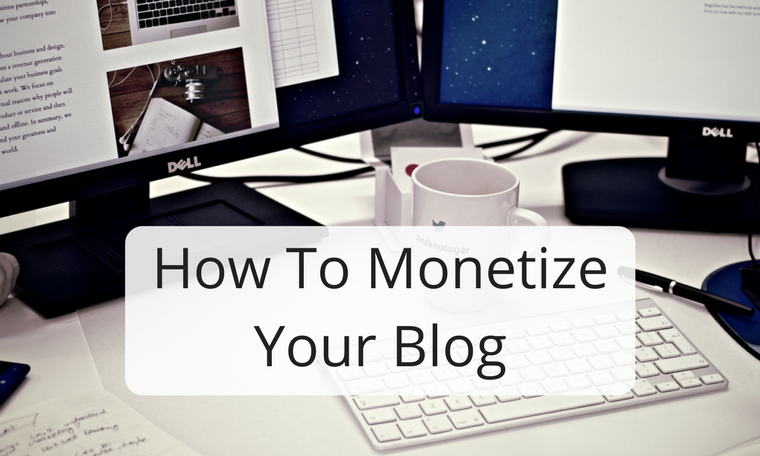
How To Monetize Your Blog
There are many reasons to start a blog. One of the main reasons is often to earn enough money with a blog to escape the 9-5 life and start living a life of freedom.
Unlike those bloggers where teenagers share their angst-filled thoughts, you’re blogging as a business.
You’re looking to turn your content into cold, hard cash. And that means you need to create a plan as to how you’re going to monetize your blog.
Let me share with you the following three ways to do it:
1. Sell Your Own Offers
Do you have your own products or services? If so, then your blog is a natural outlet for advertising these offers. And best of all, there are plenty of ways for you to promote your offers on your blog, including:
Using graphical ads. You can place banners and graphics of all sizes in your header, sidebar, footer and even between the content.
Note: A word of warning, however: Just don’t stuff your blog so full of graphical ads that it looks like a circus rather than a blog.This will rather get the people leaving your blog than reading your content.
You can place your text ads in the same places you put your graphical ads. Your blog should be about great content and not be overwhelmed by ads.
This is often one of the best ways to advertise your offers because it puts your ads directly in front of your readers. In other words, you can create blog posts which contain promotions.
Nobody likes to read ad after ad. Your blog readers are coming to your blog for the great content– not the ads.
Instead, you can weave your offers directly into useful content.
Example: If you’re writing a “how to” article about how to lose weight, you might have a step that talks about reducing calories. You can then include a link for your low-calorie cookbook.
If you really are interested in selling your own products I can recommend ClickFunnels. With Clickfunnels it is very easy to build high converting landing pages and sales funnels. (See here my review)
2. Promote Affiliate Products
Usually, if you start blogging you don’t have your own products or services. That is absolutely no problem.
Another option is for you to promote affiliate products on your blog. This includes:
Digital products, such as those found at Clickbank.com. These are often some of the best products to promote, simply because they usually have high commission rates (50% or more).
Physical products. Because of the overhead and fulfillment costs associated with physical products, these tend to have low commission rates– as little as 5% or 10%. Depending on what you’re selling you may have high conversion rates, especially if you sell through a trusted vendor like Amazon.com.
Services. These also tend to have lower commission rates, simply because the vendor is trading his or her time for dollars. There are exceptions, such as certain services which the vendor may have automated or otherwise found out how to do at a low cost.
And some of these programs also award recurring commissions to affiliates. This means that if you sell the program once, you get paid again and again for as long as your referral remains a member of the program.
Here’s a hint: If you want to start selling products, it is always a good idea to start a mailing list. If you want to know how to start with email marketing check out this post!
Let’s say you send your visitor to an affiliate product. Of course, only a small percentage would immediately buy the product.
Again, don’t do too many ads. Try always to bring value first and then advertise.
3. Sell Advertising
Another way to monetize your blog is to sell advertising to other marketers in your niche. Here you can sell banner ads and other graphic ads, text ads, links (especially if your blog has a high Google Page Rank), and even ads embedded directly in your content.
The benefit of this particular monetization method is that you get cash in your pocket no matter what happens with the offer. In other words, you’re not in charge of writing ad copy or trying to figure out how to get your visitors to buy an offer. All you have to do is sell the advertising space and let your advertisers take care of the details.
The money you get per visitor is pretty small. I would always recommend trying affiliate marketing because the earning potential is much bigger and no one wants to see a website with a lot of ads on it.
And of course, you can certainly use more than one method at any time. You just need to do a little testing to see which methods bring you the greatest revenue.
What method did you try on your blog? And what has been your most effective? Let me know by writing a comment below!

How To Setup An Affiliate Program
If you want to sell a product over the internet or maybe you are already selling a product over the internet, the best thing you can possibly do to boost your sales is to set up an affiliate program.
In this article, I’m going to show you why you should set up an affiliate program and how you can easily do that.
Why should you set up an affiliate program?
If you want to sell your product online you need a sales funnel. With the right kind of software that can be very easy (learn more here). After building a sales funnel you need traffic. Without traffic, no business can survive.
There are many different traffic sources and they all vary in their quality, price, and effectiveness. For example, there is SEO, Google Adwords, Facebook Ads and many more.
And they can all be great selling a product. If you already have a blog with good traffic you can use that (SEO). Or maybe you set up a Google Adwords campaign for your product.
However, if you are selling your own product there is one traffic source that outmatches all other traffic sources and that is affiliate marketing. If you don’t know what affiliate marketing is, check out this post.
Why is affiliate marketing so effective?
Let’s say you have a product in the personal development niche. There are already tons of people with a huge email list interested in personal development, there are many blogs with a huge audience in the personal development niche, there are podcasts about personal development with millions of listeners.
Can you see where I’m going with that?
If you can convince the owner of a huge email list that your product can be very helpful for his leads and he accepts that and promotes your product you have access to the size of his email list!
And he can even earn a lot of money too! That’s the perfect win-win situation.
You don’t have to invest any money and you can have thousands of sales! Of course, you have to pay commission for your sales, but hey, you don’t have to set up any marketing campaign or put any effort into marketing.
How to setup your affiliate program
Now that you know why you should set up an affiliate program, we need to have a look at the technical details. I believe that using the right tools can save you a lot of time and effort when it comes to setting up the technical details.
I’m sure there are many tools that can help you set up an affiliate program but I always recommend ClickFunnels (see here my review). With ClickFunnels it is very easy to build high-converting sales funnels and to set up an affiliate program.
In the following, I’ll show you how you can set up an affiliate program with the help of ClickFunnels.
Setting up an affiliate program with ClickFunnels
If you create a sales funnel with ClickFunnels you’ll be able to easily create an affiliate program with Backpack. If you never heard anything about Backpack you can watch this short video:
You only get access to Backpack with the Full ClickFunnels Suite (Sign in here for your free 14 days trial)
Now, I’ll show you the three simple steps you need to do to set up an affiliate program:
Step 1: Add an affiliate program to your funnel
At first, we have to create the affiliate program for your funnel. That means we have to create two more steps in your funnel. We need an affiliate access page and an affiliate program page.
On the access page, new affiliates can register and give you all the information you need, like their name, their email, their PayPal, etc. Your funnel should now look something like this:

The affiliate program page will give your affiliates all the tools they need to successfully promote your product. That includes banners, swipes, etc. The better the material you offer is, the more successful your affiliates will be and the more money you’ll make!
So here it can be really lucrative to invest some time.
Step 2: Set up a commission plan
In this step, you have to decide how much % your affiliates will make by selling your product. Setting up a commission can be a little tricky. The lower the commission will be the more money you’ll make. However, if you set the affiliate percentage too low nobody will be your affiliate.
I would suggest using a percentage of 30-70% for digital products. The higher the commission will be the more affiliates want to promote your products so take some time to come up with a good percentage.
To set up your commission plan go to Backpack and commission plan. Here you need to click on “Add Commission Plan”.
You can now enter a name for your commission plan. The name is not that important, however, you should remember this.
If you know go back to your funnel settings, scroll down to backpack, and enable affiliates you can choose now this commission plan you just have created:
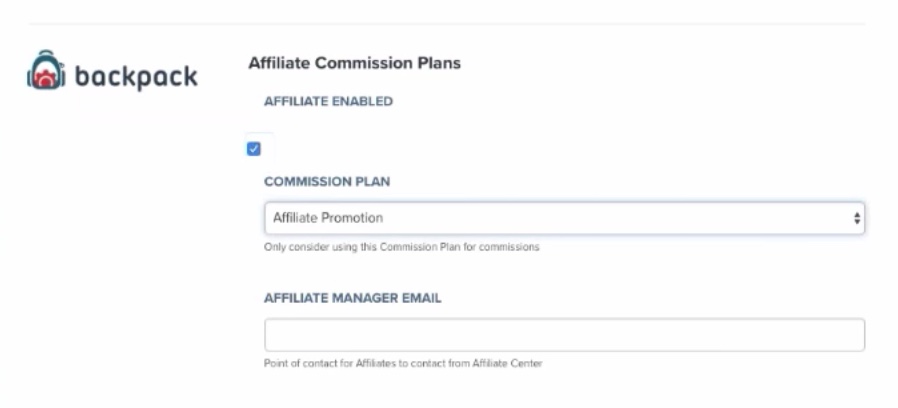
Step 3: Create affiliates types
Now you can go back to Backpack and your commission plan. Here you can now add different types of affiliates. Why should you set up different types?
Well maybe you have a joint venture or ‘VIP affiliates’ (the people with a huge audience) and you want to give them a better commission than the ‘normal’ affiliate.
At the beginning, I think that one type of affiliate is more than enough.
You can also set up different tiers if you want that. For example, if you have a product with a monthly subscription setting up 2 tiers can be very good because that motivates your affiliates to find more affiliates because they can earn more money.
Now your affiliate program is ready and you can start earning commission!
As you can see it is very easy to set up an affiliate program with ClickFunnels. I will show you one extra feature of Backpack that can really help you boost your sales.
Run affiliate contests
You should always try to please your affiliates and find ways to motivate them so they keep promoting your product. A very good way to do that is organizing affiliate contests. The bigger the prices are, the more motivated your affiliates will be.
Russell Brunson once ran an affiliate contest with a brand new Ferrari as the #1 price. Think about how much people started promoting his product! However, it doesn’t always have to be a Ferrari 😀
It can be a cash bonus of $1,000, a nice watch or something like that. Here you can get creative.
Conclusion
There are many good ideas for products out there but many of them fail because of the technical details. However, the technical details aren’t very hard if you use the right tool.
As you can see with ClickFunnels it is very easy to build sales funnels with affiliate programs. Here you can start your 14 days free trial with ClickFunnels.
Have you already set up your affiliate program? Have you used ClickFunnels or some different tool? Let me know by leaving a comment below!
